After the mortgage crisis of 2008, when new regulations and criteria for granting mortgages were enacted, mortgage technology saw a dramatic shift. It gives lenders an additional challenge when considering whether or not to upgrade to the latest cutting-edge technology, as compliance and safety are primary concerns.
With the help of application programming interfaces (APIs), financial institutions can build extensive technological ecosystems that enable the seamless exchange of data and information across different systems – with many more benefits in terms of reduced hours from staff and other expenses.
Companies like Salesforce, eBay and Amazon have launched API capabilities to interact with other tools required to extend their reach, making the early 2000s a pivotal period for APIs. Specifically, APIs have evolved since then exponentially, making it possible to digitize many aspects of today’s standard of living, including mortgage technology.
APIs are utilized in many different applications and programs, like opening bank accounts and verifying identities, to integrate several valuable features into a single, streamlined interface.
What Are API Layers?
APIs enable businesses to share data and features with external third-party developers, business partners and internal departments. With security in mind, APIs are specifically designed to provide secure data flow across systems by mediating interactions between apps and web servers.
Ultimately, this allows for more convenience and security for both lenders and borrowers. APIs assist lenders and service providers in streamlining processes and improving communication, which can help enhance customer service.
Here’s how it works:
When a prospective borrower starts an application, the API will collect the data from the application. Uniform Resource Identifier (URI) requests to transmit data from an application to a web server. These requests consist of a request verb, header, and sometimes, the request body.
In response to a valid request, a web server’s API will contact the web server’s external program, which will then send a response containing the desired data back to the API. Sound complicated? It is!
The idea behind all of these communication levels is to ensure the application is legitimate and complies with all the latest regulations and safeguards to prevent potential fraud.

Types of API Layers Used in the Mortgage Industry
You may be asking whether there is a distinction between the numerous uses of APIs across businesses and even software. It’s not even necessary to consider other industries as there are clear distinctions within the mortgage technology itself.
Here are APIs developed explicitly for the mortgage industry:
- Opening a bank account of any type
- Digital identification
- Automated evaluations
- Anti-money laundering systems
- Mortgage applications
- Affordability (specifically to qualify prospective clients for your products)
- Property data enrichments
- Conveyancing
- Evaluations of criteria
Despite its widespread usage in speeding up the digital transformation of financial institutions, it begs the question, “Does every lender really need it implemented if their conventional techniques have been functioning for decades?”
Why Are Mortgage API Layers Necessary?
With mortgages being a significant source of income for many banks and the industry being famously slow to change, some borrowers may still need to visit the office in person to apply for a mortgage despite the digital age.
Subscribe to BeSmartee 's Digital Mortgage Blog to receive:
- Mortgage Industry Insights
- Security & Compliance Updates
- Q&A's Featuring Mortgage & Technology Experts
Among many other benefits, this is an example of where APIs come in: they make it possible for borrowers to apply safely online and lenders to approve loans without the borrower ever having to leave the comfort of their own home.
According to Fannie Mae, APIs have become indispensable for various businesses, including mortgage lenders. APIs allow lenders to automate operations, ensure accuracy and decrease costs and workloads.
Ultimately, APIs dramatically change the strategy of digital mortgages by finally allowing multiple programs to talk to one another in a secure environment.

Benefits of API Layers
If you’re considering adopting APIs into your lending business, you may be curious about the advantages beyond the obvious time savings for both lenders and borrowers.
Here are the benefits of API implementation for lenders:
- Workflow automation: With APIs, you can use automated reports and programs securely, reducing costs and time and more importantly, human errors.
- Secure connections: Due to the large number of programs involved in digital mortgages, a safe link between origination and closing is made possible through APIs. This removes the need for human data input at each stage, reducing the risk of human errors.
- Seamless order fulfillments: APIs enable users to stay in a single system for the whole process, from application to close, reducing time and staff-associated costs.
- Data transfer: APIs can seamlessly streamline data transfers between internal and external systems.
- Simplification: Borrowers can easily access or provide information using external APIs, while internal APIs streamline processes like origination and servicing.
- Expedited processes: Faster and more accurate updates to lender statements and loan data are made possible by automation.
- Tight integration between the CRM, POS and LOS: API integrations allow three of the most critical systems to remain in sync with one another.
There are also several benefits for the borrower:
- One-point of access: In the past, borrowers had to complete several time-consuming and labor-intensive documents, resulting in mistakes and the loss of crucial time. By having one-point access to the portal, they can fill out and submit forms only once and leave the rest for the lender.
- Convenience: In addition to not having to fill out several forms, borrowers no longer have to submit documents in multiple locations or visit the bank in person, saving them both time and money.
- Secure connections: With the rise of the digital era, many borrowers are concerned about security breaches when they input or upload sensitive information into apps. Using various layers of protection, APIs enhance the security of information.
- Expedited process: By eliminating the need to fill out countless forms and enabling lenders to extract information automatically, APIs can exponentially accelerate the process for borrowers.
- Real-time tracking of the process: In the past, borrowers were frequently left in the dark between the various stages of their mortgage application. However, with the help of digital mortgages and APIs, they can track and monitor their application anytime.
APIs are advantageous for lenders and borrowers due to their extensive variety of features and safely connecting to other software.

Does My Mortgage Business Need APIs?
If you’re wondering whether or not your mortgage business needs APIs, the short answer is that it depends on how much value you’d get from using them. Lenders often choose to use the extensive functionality and ability to automate processes to build customizations and customized solutions without the need to migrate to a different platform or manually input this data.
Here are some questions you can ask yourself:
- What labor-intensive and time-consuming repetitive tasks do my loan officers and I do daily?
- Is there any potential information borrowers don’t have available that I’d like to share with them in real-time?
- Are there any existing features or workflows we’d want to add to any of the software we use?
- Would automation increase the efficiency of my staff?
- Would automation allow my staff to spend more time serving customers?
If you replied “yes” to any of the above questions or considered any of them, you and your business could likely benefit from APIs.
The Future of API Layers in Mortgage Technology
As new software and regulations are released, keeping up with them and providing advanced protection for critical client data becomes more challenging. This is where APIs have begun to significantly influence the mortgage industry by providing safe communication between applications. Mortgage technology is still rapidly evolving to better serve clients and lenders by allowing them to operate their companies more efficiently and remain customer-focused.
Using BeSmartee’s POS, you won’t have to guess your way around mortgage technology or how to integrate API layers into your software. Contact us at (888) 276-1579 or email our mortgage technology experts at sales@besmartee.com.




